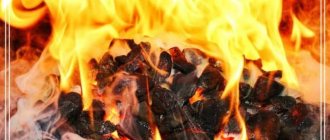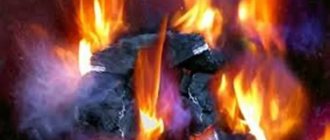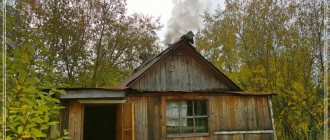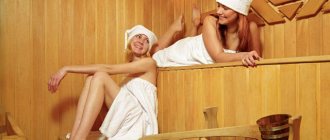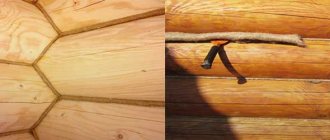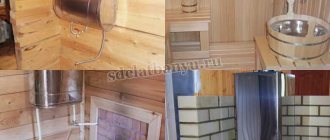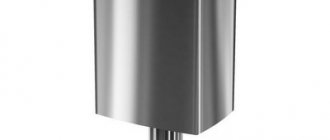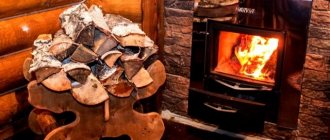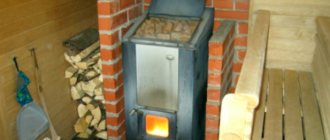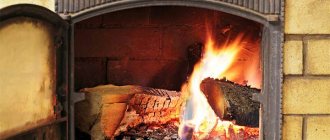Over the 2 thousand years of the existence of baths, certain traditions of taking bath procedures have developed. And before them, you should prepare the logs and properly heat the bathhouse.
If the stove is wood-burning, then its firebox is a whole science and it will be useful to learn how to properly heat a bathhouse with wood.
Proper heating of a bath requires the availability of high-quality and dry firewood.
The type of wood will determine how quickly the bathhouse will heat up, how long the heat will last in the stove, how much soot will be released during combustion, and what kind of spirit there will be in the room.
How to heat a sauna
Heating a sauna is an art.
You need to know its subtleties: how to properly add firewood, what material to use, to what temperature it needs to be heated. The ideal, safe and profitable fuel is firewood.
Before taking bath procedures, you need to prepare it. Be sure to fill the boiler with water first.
First you need to put things in order. Wash floors, ceilings and all shelves using antiseptic agents. Ventilate the room well.
Preparation takes place in several stages:
The secret of brick kilns
Traditionally, several types of stone stoves are used to heat baths. The more massive the stove, the more difficult the ignition process. For example, a Russian stove in a bathhouse, which is used a couple of times a month, is sometimes very difficult to light, especially if the building has been standing in the cold for a couple of weeks and is completely frozen, from the cap on the chimney to the foundation.
The easiest way to heat a sauna is with traditional Dutch ovens or fireplace stoves.
The mass of the Dutch oven is small, the wall thickness is at best half a brick. Therefore, it is enough to check the state of the draft in the pipe, and you can set fire to the wood.
Then everything is simple, two logs of wood are placed in parallel in the firebox, the driest ones that are available in the firewood supply. Wood chips are laid out on top of the logs, set on fire and the material is placed so that the lower logs warm up and begin to smolder. The rest of the firewood is loaded into the stove to capacity and waits for the first burnout.
After ¾ of the stored firewood has burned out, the firebox is loaded with a second portion, the valve is closed, and you can go steam.
Fireplace stoves are 2-2.5 times heavier than Dutch stoves; in addition, the fire in the hearth must be constantly maintained by adding a fresh portion of firewood. If the bathhouse is supposed to be heated with a fireplace, then a separate person will be required to manage the process - a stoker, whose responsibilities include managing the process of burning wood.
A fireplace stove has one advantage - very strong draft. When wood is burning in the hearth, there is a real draft in the dressing room. Therefore, to gain heat and heat in the heater, you can burn peat briquettes along with firewood. Only after the cast-iron mirror, screen and fireplace chimney have warmed up to maximum temperature, can you install a screen in front of the fireplace, close the damper and only maintain a small flame so that the draft in the chimney takes away smoke and carbon monoxide from the dressing room.
Additional tips for lighting your stove
For efficient and trouble-free operation of a coal-fired stove, follow a number of simple rules:
- To light coal, you cannot use flammable liquid mixtures - kerosene, gasoline, etc. It is also prohibited to use household waste.
- During kindling, be sure to monitor the process and move on to the next stage in time. It is convenient to observe the combustion through the door with heat-resistant glass. Many Teplodar stoves are equipped with this option.
- Either the ash pan or the flap must be open. When coal and wood are burning, the combustion chamber must be closed.
- The normal combustion mode can be determined by the color of the flame - it should be golden and the smoke should be transparent.
We invite you to familiarize yourself with Heat-resistant paint for stoves: metal, brick, brand, their characteristics, prices
In addition, regardless of the type of solid fuel used, it is always necessary to monitor the draft in the pipe. You need to clean the chimney 1-2 times a month.
For efficient and trouble-free operation of a coal-fired stove, follow a number of simple rules.
The difference between a metal and brick stove in a bathhouse
A metal stove warms up very quickly during combustion and can reach operating combustion mode within 15-20 minutes from the start of combustion. This allows you to heat the room as efficiently and quickly as possible. But this also brings with it some inconveniences.
For example, the consumption of firewood for long-term heating will be greater in a metal stove than in a brick stove. Let the brick oven warm up much longer and reach the operating combustion mode. But after the brick stove has warmed up, it can maintain a very stable temperature not only in the firebox, but also in the chimney.
How to level out these differences and add the positive aspects of a brick stove to the advantages of a metal stove? The simplest option is to use a brick shield with a metal stove, as well as install a brick chimney with a sleeve for a metal sauna stove.
In this case, more firewood can be added and the burning time will be extended. The process of heating the steam room in the bath will take a little longer, but the heating will be more uniform. Not only will the area of the room next to the stove warm up, but the farthest corners will immediately warm up as well.
“The end is the crown of the matter”
Wash in the bathhouse, be born again
The end of the sauna fire can be considered a combination of the following factors: the temperature in the steam room has reached the required limit, but not less than 60C⁰, the water in the boiler is boiling, the next portion of logs has burned through to the formation of red coals and the stones in the heater are well heated.
The heating of the sauna stops immediately before the start of health procedures.
Completely close the firebox and ash door and open the valve to the limit.
Then open all the windows, vents, doors to the bathhouse and rinse the walls, shelves and benches with boiling water to remove the soot that has formed on them.
Don't forget to pour boiling water over the stones. Everything needs to be done quickly, although a normal bathhouse will not have time to cool down from such procedures.
Russian bathing skills have improved over the years, not only in terms of construction and decoration. The experience of generations has made it possible to develop special tactics for heating a steam room. Not only the knowledge of our ancestors, but also the surrounding nature contributed to the development of the scheme.
Fuel selection
When kindling, you can use firewood from different types of wood:
- Thuja, pine, spruce. They are inexpensive and burn out quickly. The main disadvantage of the fuel is the content of resins, which settle on the walls of the chimney and do not burn out.
- Birches. They flare up quickly, burn long and evenly. When burned, they release a pleasant fragrant aroma that fills the bathhouses. It is recommended to use fresh, dried wood.
- Duba. This breed has a high heat transfer rate. Prepared logs can be stored for a long time without loss of quality. Burns for a long time and heats evenly. The disadvantage is the high price.
- Acacias. High thermal conductivity. Provides uniform heating.
- Aspen, poplar, linden. They have low density and burn out quickly. Do not provide strong heat.
- Hornbeam. They have a high thermal conductivity. The flame is smokeless, the burning is long, even, the heat is strong.
A separate type of solid fuel that is gradually gaining popularity is pellets and briquettes. The first are granules that are made from sawdust by pressing. The latter are similar to bricks, made from sawdust of different sizes. The main advantage of these types of fuel is long burning and intense heat.
Firewood or coal?
At first glance, coal appears to be an attractive fuel. However, coal burns differently than wood. Having caught fire, the briquette gives off the first portion of heat with lightning speed, and then smolders for a long time. This pace is suitable for heating a house, but not for bathing procedures.
Compared to coal and gas, wood is almost ideal. They are not explosive, give a uniform, long-lasting combustion, and are relatively inexpensive. Firewood can be replaced with other solid fuel, but not coal, but wood products - for example, fuel pallets.
What are the alternatives?
In addition to the types of wood listed above, peat briquettes are popular. Their advantage is that they do not need to be chopped, dried or otherwise prepared for burning.
Sawdust can be used instead of lump wood. But you still need firewood. With their help, kindling is carried out, followed by sawdust, which should make up no more than a third of the total volume of fuel.
Most commonly used types of wood
Each type of wood has its own density and calorific value. These indicators affect the amount of fuel burned that is necessary to achieve the desired temperature in the room.
If we compare tree species growing in Russia in terms of heat release, then the hornbeam has the highest value, and the poplar has the lowest. Consequently, to warm up the steam room to the required temperature, less hornbeam firewood will be required, and more poplar wood. From this we conclude that the best firewood for a bathhouse is hornbeam.
However, it does not grow everywhere. Therefore, you should pay attention to what kind of wood is common in the area where the bathhouse is located. Let's give an example: hornbeam has the highest calorific value. But if the bathhouse is built in a place where it does not grow, then a lot of money will be spent on purchasing hornbeam firewood. Therefore, to fire a stove in a sauna, you should choose wood with the highest heat transfer value among those that are common in the region where the sauna is located.
The most common species are birch and alder. Burning occurs evenly with the release of beneficial essential oils. Also, spruce and pine grow in all regions, but if there are other options, it is better not to use them. They burn quite quickly and release resins that can clog the stove chimney.
You can heat a sauna with the following types of wood:
- Hornbeam has the highest calorific value. Burning takes a long time and no smoke is produced.
- Linden , aspen and poplar have a relatively low density. What is the reason for their fairly rapid combustion without the formation of coals, they have a low calorific value.
- Acacia - has a good calorific value and maintains a constant temperature in the combustion chamber.
- Oak is a good fuel for a sauna. As it burns, the steam room is filled with a pleasant forest aroma. Harvesting firewood from oak begins in late spring (others - at the end of winter or early spring). It has a high heat transfer rate, but its cost is also high. Such firewood can be stored for quite a long time without changing its quality and performance.
- Spruce , pine, thuja - grow everywhere, their price is low, and are used only if it is not possible to use other species. The main disadvantage of conifers is their resin content. They do not burn completely and fall on the walls of the chimney, as a result of which it becomes clogged.
- Birch flares up quickly, combustion occurs evenly and for a long time, while substances are released that clean and disinfect the steam room, and also fill the air with a pleasant aroma. The best firewood is one that has been recently dried, as the aroma is significantly reduced 3 years after the tree is cut down. When using birch firewood, the air dosage must be observed. If smoke is generated, tar will begin to be released, resulting in the chimney becoming clogged.
Not all logs are good for kindling.
Much in the bath business depends on the choice of firewood. It is better to give preference to hardwood species: oak, ash or maple. Birch brooms steam well, and the logs of this tree give off good heat in the oven. Therefore, it is also recommended to take a closer look at this option.
The efficiency of firewood from fruit trees is slightly lower, and it is not harvested on an industrial scale. But if there is an opportunity or you decide to get rid of apple trees or pear bushes on the site, they are also good for heating stoves in the bathhouse.
Coniferous woods perform poorly in generating heat. In addition to the fact that they quickly burn out and release tar deposits, increased formation of soot negatively affects the chimney, clogging it. Also, you need to discard the following firewood:
- old logs give off an unpleasant odor when burning;
- Rotten wood produces little heat, but a lot of ash;
- old impregnated boards are completely unsuitable for a bath;
- Young oak logs do not have high heat transfer.
Knotty firewood also does not show its best side. Typically, this type of wood burns faster. But if these are birch logs, then they can be used for the initial ignition.
Bath procedures will be beneficial only if the kindling technique is followed correctly. Follow the recommendations given and then no carbon monoxide or high temperatures will spoil your “sacred ritual”.
Hello to all hot steam lovers!
This article will be useful, first of all, to city residents. Nothing new will be said for the villagers, because not all of our villages and villages are supplied with gas. We will talk about how to heat a bathhouse correctly and so that the result always meets your expectations. To some extent, firing a sauna stove is a kind of art.
It would seem that there is nothing complicated about this, but not everyone will flood and prepare a bathhouse “as expected” the first time. For some, the stove smokes, for others, the bathhouse takes a very long time to heat, and for others, the wood does not burn at all. And so that there are fewer such unpleasant incidents, this article will help you.
From this article you will learn:
What kind of wood to heat the bathhouse with?
You can heat a sauna with a variety of wood types. We have all sorts of trees, and each of them behaves differently in a sauna stove. In order to heat the stove perfectly, the wood must burn for a long time, produce a lot of heat and little smoke.
Bad, rotten, moldy firewood can simply ruin the entire sauna process. The bathhouse can become completely saturated with unpleasant aromas.
Be reasonable, do not use painted boards and other wooden rubbish for the firebox, I assure you, it will not bring any benefit! Old junk can be toxic and unsafe for you and for the queen of the stove herself!
Oak firewood
Young oak will give a wonderful aroma in the bathhouse and create a unique atmosphere, but there will be no real heat from such firewood. Old oak wood is also not suitable for a stove; it is too decrepit and old, and produces ash rather than heat. The air in the bathhouse will be heavy and don’t expect light steam.
If you choose oak as a sauna fuel, then opt for a middle-aged tree. Firewood must be strong, dry and under no circumstances rotten!
Rotten firewood does not provide heat, it only smokes. But strong oak logs will heat up the bathhouse properly!
Oak is famous for its hard structure, it burns for a long time and produces a lot of heat. Oak firewood is economical; to properly heat a bathhouse, its consumption will be much less than other firewood.
Birch firewood
The most popular fuel in the sauna world is birch firewood! They heat a sauna perfectly, light up easily and burn evenly, their coals retain heat for a long time.
The birch heat from the stove disinfects the air in the bathhouse, making it light and soft. In a bathhouse heated with birch firewood, hot air is inhaled much easier.
Birch firewood has excellent heat transfer, it is almost 30% higher than the amount of thermal energy that pine or aspen provide when burning.
Wood and birch bark are extremely rich in tar, which is nothing more than a carbon compound. It is birch tar that allows you to quickly build a fire and burn logs well.
Birch bark replaces paper for lighting the bulk of firewood in the stove.
Birch fuel has only one drawback - it quickly deteriorates and deteriorates. Rot appears inside the logs; there is no heat from such firewood. The service life of harvested birch firewood is no more than two years.
Alder firewood
Alder firewood is very similar to birch firewood. The spirit of alder firewood in the sauna will make you cheerful and energetic. And popular beliefs say that a sauna heated with alder is an excellent anti-cold remedy.
Alder is a good wood for a sauna stove. Firewood produces almost no smoke, produces a lot of heat and can be stored for quite a long time. When burning, this tree emits beneficial fumes, which perfectly clean the chimney of soot.
Alder firewood dries well and does not require special drying conditions.
Linden firewood
Linden is a special tree and can also be used to heat a sauna stove. It’s just that you’re unlikely to be able to light the wood quickly.
Linden logs light up slowly and difficultly, but then burn well, heating the sauna stove perfectly.
There is no secret that linden is a healer! In ancient times, warriors who were wounded in battles with foreigners treated their wounds in a hot bathhouse heated only with linden wood. After the bath we drank linden honey and quickly recovered.
Linden firewood, like birch firewood, has a limited shelf life (no more than two years). After this period, the firewood quickly deteriorates.
Aspen firewood
Aspen firewood is not the best option for high-quality heating of a bathhouse. There is no excellent heat in aspen! However, aspen has an amazing property. When burning, wood does not produce soot or smoke and emits (like alder) special fumes. It is these fumes that are super-disintegrators of soot in the furnace chimney.
The soot simply falls into the furnace and the furnace vent, where it can be easily cleaned out. Thanks to this amazing ability, aspen wood must be used to fire the stove.
Poplar, Willow, Ash firewood
I combined these three trees into one story of firewood for a bathhouse. The fact is that they are in no way suitable for the queen of a sauna stove. They burn out quickly, do not produce heat and are of low quality.
Willow and ash smoke is very acrid and bitter, if it gets into the steam room - disaster!
Conifers
All coniferous trees are rich in resin, so they burn well, evenly and quickly. Coniferous wood is rich in essential oils; they create this unique forest aroma in the steam room. But in order to heat the bathhouse hotly, you need quite a lot of such firewood.
The downside of pine wood is that when it burns, it produces a lot of smoke, which clogs the chimney. When burning, conifers crackle and sparks fly from them, therefore you need to monitor fire safety in the bathhouse.
Finishing the conversation about firewood for the bathhouse, I would like to add that it is advisable to choose even logs for the stove, without knots. Knots on logs are future firebrands that burn out for so long that all the heat from the bath will fly out of the stove and onto the street!
The right firewood is the key to success
The most important thing is to choose the right logs. Experienced craftsmen advise choosing hardwood trees, for example, oak, maple, ash, etc. When burned, such material will give off the maximum amount of heat.
Next on the list of heat transfer are fruits:
Apple tree
Cherry
Pear and others
They will also provide good heat, but a little less than previous hardwood options.
Basically, aspen, alder, birch, etc. are used for fireboxes. Ordinary hardwoods are cheap and widespread, so this is one of the most popular options.
But it is not recommended to use coniferous firewood. In addition to the fact that such a tree will give off little heat when burning, a lot of soot will be formed during combustion.
It is also worth paying attention to the moisture content of the firewood. Only firewood with a humidity of no more than 20% is suitable for kindling. It is important to understand that the humidity of fresh branches is from 30 to 50%.
To achieve optimal results, you will have to dry them first. This is done easily; the wood is left in a ventilated area.
You cannot use old and rotten boards or painted wood for kindling.
Advice! The most famous bath attendant in the Russian Federation, Ivan Boyarintsev, recommends using aspen wood for kindling for at least 3 years of storage. Such firewood will give excellent heat and create a special atmosphere in the steam room.
Further instructions are divided depending on which sauna is available.
What is the best way to heat a new sauna for the first time?
It is not recommended to heat the steam room too much for the first time. It is better to heat it little by little over several times so that the stove dries out and “adapts” to work. The next five times should be done “increasingly.”
| The steam room should warm up to a level of 50 - 60 degrees and about 60% humidity. |
How to efficiently heat a relaxation room in a bathhouse in winter?
Heating option No. 1 - simply open the doors in the sink, steam room and relaxation area while the stove is firing, and the room will warm up. This volume of heat should be enough for the period of bath procedures.
Option No. 2 – gas convector. Relatively easy to install, fits organically into the bath design.
Option No. 3 – an exclusive stove with a glass door similar to a fireplace. It costs more, but it looks stylish. Even when the stove in the steam room cools down, the relaxation room will be warm and cozy.
| In the case of a new stove, “running in” the structure is important, and sudden kindling is not necessary. |
Useful recommendations for high-quality kindling of a sauna stove
- At the very beginning, open the blower to the maximum - for a more effective flow of fresh air;
- Use firewood wisely. After about 5 - 8 kindlings you will understand how much wood is needed. In the future, simply cook this volume to avoid overheating.
- To control temperature and humidity in the steam room there must be a thermometer and a hygrometer. Update them regularly.
- If you have not heated the steam room for a long time, it will take a little longer to warm it up. With regular heating, it takes about a third less time to warm up the steam room.
Bringing the steam room to the required temperature - continue the kindling
To properly heat the sauna, you need to periodically “feed” the firebox with firewood. The first replenishment is approximately 15 minutes after the “seed”. Open the oven door and use a poker to smooth out any remaining solid fuel. After this, evenly lay a portion of the firewood - leave about a third of the firebox free.
It is advisable to place the firewood closer to the damper, but not close to it. The minimum distance increases heat transfer and reduces the time for full heating of the steam room. However, contact of fuel with the door can lead to unpleasant consequences.
The next toss of logs is in an hour and a half. The frequency depends on the type of wood and your skill. Ideally, the intervals should be as large as possible, but without losses in heat transfer. Within a few hours the room warms up. After this, the chimney valve can be slightly closed - this will give a small saving in firewood.
In summer, lighting a bathhouse takes 3-4 hours. In winter, the process takes up to 5-6 hours. When the heating procedure is over, it is necessary to open the firebox damper and check the latter for the presence of carbon monoxide; if blue tongues of fire are dancing over the coals, there are problems - this means that after the bath procedures you will need to clean the chimney; if everything is in order, then you need to close the vent, firebox and chimney.
The kindling is finished, but this is not the end yet. After warming up, the room needs to be ventilated again. Open the window and doors for 10-15 minutes. After saturating the room with fresh air, close the doors, but do not touch the window. Let the bath brew - a couple of hours will be enough for this.
During this time, the room will not have time to cool down, but the heat will become uniform and soft, and the steam will become light. All that remains is to close the window and begin the most enjoyable part - the bath procedures.
To speed up the process, do not water the stones. This will lead to the formation of steam, but will not give the desired effect. The stones are sprinkled during the sauna relaxation process.
How to properly heat a sauna with a metal stove?
Owners of such heating devices should remember the main advice - to lay logs often, but little by little. Otherwise, you will cause the oven to overheat, after which it will take a long time to cool down.
Distinctive features of the iron stove:
- It warms up quickly. Such settings reach optimal mode within 20 minutes after igniting the wood.
- Heating of the room begins as soon as the device itself warms up.
- An iron stove requires more fuel. Firewood or briquettes burn much faster than in a classic brick heater.
- Such stoves do not always maintain the same temperature in the chimney and combustion chamber.
A metal heater can be supplemented with a brick shield. Some lovers of Russian baths do just that - they line the appliances with bricks, thus increasing the time of heat release.
The technology for lighting a metal stove includes the following steps:
- Place some paper on the bottom of the firebox.
- Place the logs on the paper (not too tightly).
- Fill the combustion chamber two-thirds full.
- Light the paper with a match.
- Add new logs only after the previous ones have completely burned out.
Avoid the following common mistakes:
- excess firewood overflowing the combustion chamber,
- excessively dense arrangement of logs,
- closing the stove vent too early.
It should also be remembered that the flame in such a heater should not be too strong. It is much better when the firewood smolderes slowly, releasing heat evenly into the room.
Types of devices
- Cast iron sauna stove with open heater. The most common type. The stones are located in a niche above the firebox: the surface of the hot walls heats the stones, which in turn release heat into the room. An open-type heater not only saves firewood, but also heats up faster.
- Stove with a closed heater. It takes longer to heat up than an open one, but the heat is distributed evenly. The steam that comes out is lighter and thicker. The main advantage: the unit has to be heated less often. A closed heater ensures fire safety and heats larger areas compared to an open one.
- Sauna stove made of cast iron with a water tank. The tank can be suspended or built into the device itself. The second type is not very convenient to use: you cannot control the amount of remaining water.
How to heat a sauna with an electric heater?
Heating devices of this type do not require such serious preparatory work. For the first testing, it is enough to install a new stove in a suitable place outside the bathhouse and load the required volume of stones (this should be specified in the instructions for the specific model). After this, start the electric heater according to the following scheme:
- Press the main switch at the bottom of the case.
- Set the oven heating temperature to 50 °C.
- The device will operate for an hour and then turn off.
When turned on for the first time, the electric heater may emit foreign odors, which is quite normal. However, if they do not disappear after 2-3 uses, you should contact customer service. Perhaps you haven’t fully figured out how to properly heat such a stove.
The second switching on of the device also has its own characteristics. The temperature here needs to be set at 80 °C to warm up the stove even more. This time you cannot pour water on the stones yet: this can lead to their premature destruction. Follow the operating instructions and carefully monitor the operation of the oven. If after 2-3 test runs you do not notice anything alarming, then the device can be safely placed in a Russian bathhouse and used for its intended purpose.
How to light a stove so it burns well
Since stoves are very different from each other, having individuality and features, there are many nuances. You can have a sauna with a metal, cast iron, iron or brick stove. There is also a slight difference depending on the time of year: in winter it is more difficult to light a stove, especially if the only fuel is coal. However, there are also general rules that will allow you to avoid common mistakes. The most common of which are carbon monoxide, heat stroke and fire hazards.
For kindling and good heat you need high-quality and dry firewood, a little patience and attention to detail. Before starting the kindling, you need to remove old ash and coals from the stove (they can then be used to fertilize the garden). Open the valve (if there are several of them, then the one that leads into the pipe opens first) and the firebox door to check the draft. The draft is checked this way: a lit match is brought to the stove, if the flame stretches upward, then there is draft, if on the contrary (the flame squats or goes out), then you need to clean the chimney. The boiler where the water will be heated is also checked - it must be full, and there must also be a supply of cold water.
When the draft has been checked and the ash has been removed, they begin to start kindling. To do this, take dry firewood, some crumpled newspaper sheets, wood chips, strips of bark, and shavings. Then a “well” structure made of firewood and newspaper with wood chips is laid out in the oven. Two firewood are stacked at a short distance from each other. The logs are located not far away, immediately behind the blower holes. Crumpled newspaper is placed between the firewood, wood chips are placed on top and the remaining firewood is placed. They are placed perpendicular to the first one at a slight angle to form a well.
Then they set fire to the newspaper; it is better to use a newspaper bundle or a long splinter for this, so as not to accidentally get scorched. If the newspaper is occupied, then the door must be closed as quickly as possible so that the smoke does not be drawn into the bathhouse. A smooth and fairly monotonous hum should appear after some time. A steady hum means that the ignition process was successful.
No buzz means the process will have to be repeated. Depending on the type of stove and type of wood, you need to add firewood after 5-10 minutes, when the first load begins to crumble into coals. Firewood is placed in the second stack in 2/3 of the firebox in even rows, the coals from the first firewood are stirred and leveled.
If the stove does not light, you can use some dry alcohol, which can be purchased at outdoor stores. The use of gasoline, kerosene and other flammable substances is prohibited.
When the second stack burns out, the next one is laid (you need to lay the firewood carefully so as not to get burned on the door). At different times of the year, the stove takes different times to heat up: in summer, depending on the stove, this time is 3 hours, and in winter this time increases by two to two and a half times. You also need to control the water in the boiler; if it boils too much, add more.
The difficulty in adding firewood is to ensure that the temperature in the stove does not drop while adding firewood. How to achieve this? The firewood is not allowed to burn out completely and the next portion is added.
Cleanliness is the key to a healthy microclimate!
First, regardless of the stove you choose for the bath, you need to clean up the room where it is located. Actually, after each procedure, the floors are washed and the remaining leaves are swept away. You need to clean up especially carefully around the stove itself. Immediately before the procedures, the room is ventilated for half an hour.
Any stove in a bathhouse is an individual mechanism. Even despite the external similarity and the same functionality. This is characterized by the fact that each stove maker approaches work in his own way. According to this, almost all of them are heated differently, but the principle of operation is the same.
There are certain rules for kindling, compliance with which will allow you to avoid unpleasant situations, such as:
- carbon monoxide poisoning;
- getting heatstroke;
- possibility of fire.
Preparatory stage
Before starting the bath ritual of lighting the stove, let's prepare it for this. Using a special scoop, empty the ash chamber (in common parlance - the ash pan), as well as the grate part. Remains of combustion products are removed from the premises. Then we prepare firewood (preferably birch) and store it at a safe distance from the stove.
Examine the heater. If it is open, rinse with water. But only if this was not done before during 5-6 bath rinses. We check the water supply in the boiler and, if necessary, replenish the missing part.
It is imperative to determine the presence of traction. We completely open the ash pan, the combustion door and the damper on the chimney. We light a match and bring it to the door. Everyone knows how to determine the presence of traction from school lessons and personal experience in lighting street fires. If everything is in order, we proceed to the following procedures. If there is no draft, you need to check the chimney. The reason for the absence may be clogging of the pipe with ash, bird nests (and they love to huddle in such places) or a malfunction of the deflector on the chimney .
For ignition you will need paper or you can use special flammable mixtures, but not gasoline. If for some reason you forgot to purchase them, follow the old “old-fashioned” method - split off the birch bark from the logs - it burns well, no worse than newspaper sheets.
Next, you need to select 4-5 dry, small logs and chop them into small wood chips. If there are none, use an ax to split the wood blanks. Now we’ll make a “seed” on the grate to ignite the fire faster. To do this, follow these steps:
- We place two logs on the grate parallel to each other, with a gap of 10 cm, immediately behind the first ash holes;
- between them we pour kindling: paper or birch bark;
- pour a small mound of wood chips on top of them;
- We press it all down on top with two more logs, placing them in the opposite direction relative to the first two pieces.
Let's make a fire
This procedure was also performed by every man. In this case, it is necessary to observe safety precautions. It’s easier if there are tiles on the floor in the bathhouse; they don’t burn; on wooden floors, you need to be careful and prepare water just in case.
Use matches to light paper or whatever you use for ignition. We wait 2-3 minutes until the fire “takes up” thoroughly and close the stove door. After 4-5 minutes, when the wood burns, you will hear the characteristic hum of the flame. We cover the vent, but not completely, but leaving a small gap, and open the valve to the water boiler.
That's it - the wood has caught fire, now you need to turn up the heat to heat the bathhouse.
You need to start adding firewood after 10 minutes, when the logs laid first begin to burn. Open the door, use a poker to slightly level the heads of the grate, and throw in 5-6 logs. Don't try to push them deep into the oven. The ends should be located immediately beyond the outermost border of the grate. Depending on the type of stove and its dimensions, you will need a different amount of firewood. But in any case, put enough to fill the space by two-thirds.
The job is done - all that remains is to wait for the temperature to rise to the required level. Again, depending on what the bathhouse is built from, its dimensions and the correct insulation, the time intervals for this will need different.
You can repeat the procedure for adding firewood, depending on how long you will be washing. Check the combustion of the stove periodically. When the firewood “settles”, level the coals over the internal space, and again throw in a few logs.
After complete warming up, you need to constantly maintain the temperature. Close the valve on the pipe slightly. When the bathhouse is thoroughly heated, there is no point in constantly adding firewood. Just level the coals on the grate and enjoy the procedures.
In winter, when the temperature drops, throw in a few pieces of wood to keep the fire burning. 3-4 logs are enough for the coals to engulf them in flames. Don't overdo it with firewood. Coals from birch logs give no less heat to the stove than an open flame.
How do you know when the sauna has warmed up?
This question is asked by all those who first encountered lighting a stove. Having correctly completed the above steps, you need to wait about two hours. Then we go into the steam room, open the door and ventilation, fill a ladle with warm water and splash it on the heater. When the oven is heated, the water will immediately evaporate, producing a sharp hissing sound. In this case, it is better to turn away, because with the first supply of water, a layer of ash will fly off the stones, falling on them during kindling.
Now we close all the windows and ventilation, splash another ladle of water on the heater and set off to prepare for the “sacred procedures”. While you are collecting bath accessories, the steam room will warm up thoroughly. When starting to steam, open the ventilation, but not all the way, so that the cold air does not “drown out” the still fragile streams of hot steam. After about an hour, you can open the vent a little more.
Key characteristics when choosing
Having chosen cast iron, you need to compare the parameters of the product with the bathhouse in which it will be installed.
Working properties:
- Productivity, characterized by the area of the room heated by the unit.
- Fuel type. Most often, buyers prefer wood stoves.
- Type of firebox (standard or extended). The extended one is mounted in the wall. You can heat the sauna directly from the steam room or from the dressing room, which is very convenient.
- Material. There are several variations of cast iron. The service life of the unit and the thickness of the furnace walls depend on the correct choice.
- Wall thickness. Best option: gray cast iron.
- Availability of a water tank and its type. There are two types: built-in and suspended. In use, preference is given to hanging tanks: it is easier to fill in water and control the level of the remaining water. The mounting location of the tank is also important: at the back or on the side. Depends on where you will install the unit.
Having decided what kind of firewood to heat the bathhouse with, you should decide when is the best time to prepare firewood. The optimal time is considered to be February - March. Wood that has been well frozen during the winter months chips easily at this time. In winter it is easier to determine whether a tree is rotten or good. To do this, you need to knock on the tree trunk with the butt of an ax: if a ringing sound is heard, then the wood is good, if the sound is dull, then the tree is rotten inside.
You should pay attention to the number of knots. If there is a large number of them, it will take a lot of time to dry the wood, and moreover, such firewood will burn unevenly, since places with knots burn longer than clean wood. It is impossible to find a tree completely without knots, but you should not use complete culling.
If you have a chainsaw, then it will be more profitable to buy whole logs and cut them yourself than to purchase already chopped firewood. But if such a tool is not available and there is no desire to manually chop wood, then they can be purchased ready-to-use.
When purchasing firewood, you should monitor the following points:
- Wood moisture content. Standards set the humidity level within 20-25%. When the humidity is below 20%, the wood will burn even better.
- Uniformity. When receiving delivery, you need to make sure that only the firewood that was ordered was delivered, and not a mixture of different species.
Previously, the ability to heat a bathhouse was called a real art. To be able to heat your own bathhouse no worse than a professional bathhouse attendant, you need knowledge of the rules of how to heat a wood-fired bathhouse and a little practice.
So, how to properly heat a stove in a bathhouse? First, the steam room must be in perfect order. All items that are not used during the steaming process should be removed from the sauna, all debris should be removed and the floor should be thoroughly washed. The shelves must be washed with an antiseptic using a brush. It is also necessary to wash the walls and ceilings of the premises. Then you should open all the windows and doors and let the room ventilate.
After cleaning, you can start heating the stove. All furnaces have their own characteristic features, so the heating will also have its own characteristics. But there are basic points that are the same for all types of stoves. Failure to follow the rules of kindling can lead to tragic consequences, such as fumes, heat stroke, and fire. Let's look at how to properly heat a stove in a bathhouse with wood.
This process consists of the following steps:
- Preparation.
- Kindling.
- Loading firewood.
- Completion of the heating of the bath.
Next, we will consider step by step how to properly heat a sauna with an iron stove.
Using a scoop, remove ash and unburnt coals from the stove into any suitable container. They can simply be thrown away or used as fertilizer for plants.
Then you need to add firewood and, for safety reasons, place it away from the firebox.
Next, the stones are prepared. If a closed heater is installed, then they must be rinsed to remove soot. If the open-type heater and steam room have already been used, then the stones need to be washed again. To do this, take warm water.
If the bathhouse does not have a full-fledged washing room with a shower, then the following steps should be taken: check the water tank (if installed) for the presence of a sufficient amount of water, prepare cool water for washing.
It is important to remember that the water boiler connected to the stove must always be filled, even if warm water will not be used. The fact is that the boiler can simply burst due to strong exposure to high temperatures.
If the steam room is a separate room with a door, then it should be closed. Next, the doors and valves at the combustion chamber, blower and smoke view are fully opened. If there are two valves in the design of the smoke view, it is necessary to open the one through which fire and smoke directly exit into the pipe; the valve of the heating channel for the water tank and heater does not need to be opened.
It is necessary to prepare the following materials:
- Birch bark. It needs to be cut into thin pieces. To do this, you can use a sharp knife. Instead, you can take shavings or chop short chips.
- Newsprint.
- 4 logs. They should be dry and small in diameter (about the same thickness). The firewood must be of such a size that it can be easily inserted into the stove firebox.
Next is the “seed”:
- Two thin logs are placed parallel to each other on the grate. The distance between them should be equal to the width of your palm. The logs should be placed immediately behind the first vent holes from the ash pit.
- The paper is crumpled and placed between the logs.
- A little wood chips are poured on top of the paper.
- The two remaining logs are laid diagonally on top, leaving a small gap between them.
It may not be possible to light the stove right away. Don’t be upset, because not everyone succeeds in lighting a stove in a bathhouse the first time. A lit match should be carefully brought to the paper and lit. The match can be replaced with paper twisted into a rope.
It is prohibited to use any flammable liquids to ignite the stove. There are times when the firewood is slightly damp. And since you won’t be able to quickly light a bathhouse with such firewood, you can use a dry alcohol tablet, which should be used according to the attached instructions.
After the paper has ignited, you can close the firebox door. At first the combustion process will not be very active. This occurs due to air pockets formed in the chimney. As a rule, after a few minutes this problem is eliminated and cravings return to normal.
With the firebox door closed, you should listen to the sounds coming from the stove. If after a few minutes a characteristic hum is heard, then the firewood has flared up. Otherwise, the kindling will have to be done again.
It is necessary to open the sub-door. It should not be completely closed, otherwise the flame will go out because air will not flow.
After about 5-10 minutes (it all depends on the design of the stove and the characteristics of the installed firewood), you should open the firebox and use a poker to level out what has not yet burned out, then you need to put firewood into the firebox. Firewood should be stacked in such a way that the front ends of the firewood are outside the boundary of the grate. They should not be placed too close to the door, but not deep either. The firebox is filled approximately 2/3.
When loading firewood, you need to be very careful: do not touch the door frame with your hands (you can get a severe burn) or logs (there is a high risk of fire).
It will take about 2.5-3 hours to heat a bathhouse in summer, and 5-6 hours in winter. These indicators are not constant and depend on various reasons, for example, the design features of the stove, the amount of heated water and others.
If you have a water boiler, during combustion you must ensure that there is the right amount of water and add it if necessary.
After a few hours, with good draft, the chimney damper can be closed halfway.
You should not burn garbage, household waste, unnecessary things, etc. in the stove, since when burned, almost all of them release substances harmful to humans.
After opening the firebox door, you need to assess the condition of the firewood and firebrands.
If the following symptoms occur, it is necessary to fully open the valves and close the blower half-door tightly:
- the firewood is burnt out;
- gray ash formed;
- the coals turned red;
- no flame;
- the stones turned red;
- water boils in the boiler;
- in the steam room the temperature rose to 60 – 90°C.
Next, windows and doors open. If soot forms on the stones during heating, it must be washed off with water. Then carefully and quickly water all surfaces of the steam room. After this procedure it will not become colder.
You cannot take a steam bath without first heating the stove. Of course, if you have an electric or gas model, then you don’t need to know any special tricks for heating a sauna. It is enough to read the instructions and strictly follow all the manufacturer’s recommendations. It’s a different matter if the stove in your bathhouse is real – wood-burning.
Not all novice bathhouse attendants know how to properly heat a bathhouse with such a stove. Uninformed beginners spend hours lighting a wood-burning stove, surprised that the temperature in the steam room does not rise above 40 degrees. Or they forget about the dampers, and then dangerous carbon monoxide becomes a companion to bath procedures. There is no need to make such mistakes. Let's start learning how to heat a sauna correctly!
Detailed instructions for heating an iron stove in a bathhouse
Adding fuel to the stove
Properly heating a sauna with wood and an iron stove is very simple. There is a special algorithm:
- Place 5-7 crumpled newspaper sheets on the bottom of the firebox, cleared of ash. There is no need to crumple the paper tightly; you should leave small layers of air between the natural folds.
- We begin to lay out small firewood (chips) on newspapers so as to cover the entire surface of the stove bottom. Between the logs of the bottom row you need to leave small gaps, about the width of a finger - this way, during kindling, air from the ash pit will flow more efficiently into the stove.
- We continue to lay the logs one on top of the other, placing birch chips slightly protruding forward between them. Any dry wood chips will do, but birch wood is easiest to light. Stop filling when the firebox is about 80% full to leave room for gas circulation. Now you can set fire to the wood.
- When adding firewood during the fire, you need to wait until the previous batch burns down to the state of bright red coals, and only then lay the next batch of logs.
The oven is lit, you can use it
Using the gate
A damper is a damper on a stove chimney. Its task is to prevent heat from leaving the room through the chimney when the combustion process is already completed.
How to use the gate correctly? The only important rule when using a damper is to close the chimney only when the combustion has already completed. Otherwise, even if there is no fire in the stove, but only active smoldering, there is a risk of carbon monoxide leakage.
Adviсe
- You can hang a thermometer and a hygrometer in the steam room - this will allow you to control the atmosphere in the bathhouse even before it completely melts and understand when you need to stop adding firewood to the stove.
- You can, by trial and error, calculate how many logs are needed to create a comfortable atmosphere in the bathhouse, and at all subsequent times simply prepare the required number in advance to avoid overheating.
- Bath brooms can be prepared in the summer and used throughout the season if stored correctly. The ideal condition for a broom during storage is hanging with the spine down.
- At the beginning of the kindling, the vent should be open as much as possible for a better flow of oxygen.
Common mistakes
- Too much firewood at once. If the firewood in the stove, especially one that has not yet been lit, is placed too tightly, there is a risk of smoke in the room, because there will be no normal circulation of gases in the firebox of the stove.
- Blower/gate valve closed too early. In both cases, violation of the order of using the stove leads to difficulty in the circulation of gases during the combustion process.
Rules for preparing firewood for a bath
Having decided what kind of firewood to heat the bathhouse with, you should decide when is the best time to prepare firewood. The optimal time is considered to be February - March. Wood that has been well frozen during the winter months chips easily at this time. In winter it is easier to determine whether a tree is rotten or good. To do this, you need to knock on the tree trunk with the butt of an ax: if a ringing sound is heard, then the wood is good, if the sound is dull, then the tree is rotten inside.
You should pay attention to the number of knots. If there is a large number of them, it will take a lot of time to dry the wood, and moreover, such firewood will burn unevenly, since places with knots burn longer than clean wood. It is impossible to find a tree completely without knots, but you should not use complete culling.
If you have a chainsaw, then it will be more profitable to buy whole logs and cut them yourself than to purchase already chopped firewood. But if such a tool is not available and there is no desire to manually chop wood, then they can be purchased ready-to-use.
When purchasing firewood, you should monitor the following points:
- Wood moisture content . Standards set the humidity level within 20-25%. When the humidity is below 20%, the wood will burn even better.
- Uniformity . When receiving delivery, you need to make sure that only the firewood that was ordered was delivered, and not a mixture of different species.
When preparing firewood yourself in winter, it should be left to dry for about 6-7 months.
